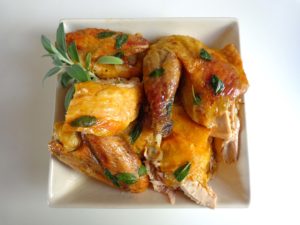
Roast guinea hen with fresh sage
Fresh sage enhances the slightly wild flavor of guinea hen with an unusual and pungent fragrance. In this recipe, the bird is roasted whole and allowed to sit for a few minutes before carving for maximum tenderness. While it is resting, you will sauté fresh sage in butter to add to the roasting juices. Be careful — the aroma of the sage may drive you mad.
If guinea fowl is not available where you live, chicken or Cornish game hen may be substituted. But do make the effort to obtain fresh sage, as its flavor is unbeatable. If you don’t have a source of fresh sage nearby, consider growing a pot of it on your windowsill.
Serve the bird with seasonal vegetables — for example, braised asparagus in spring, provençal tomatoes in summer, a pumpkin gratin in the autumn or mashed potatoes with horseradish in winter. A French-style green salad would also marry nicely.
1 guinea hen or chicken
1 clove garlic
several sprigs fresh sage
1 tbsp. olive oil
2 tbsp. butter
1/4 cup water
salt and freshly ground black pepper
Preheat the oven to gas mark 6 (350 F, 180 C).
Check the poultry to make sure all feathers have been removed. If the butcher has tied it for roasting, remove the string and open it up. This will allow the legs to cook move evenly. Cut off and discard the last joint of the wings.
Peel and halve the garlic and insert it into the bird’s cavity. Insert a couple sprigs of sage.
Lightly coat a roasting pan with about half of the olive oil, using the rest to coat the bird. Add a little more if you need to.
Place the bird in the oven and roast for 30 minutes.
While the bird is roasting, pull the leaves off the remaining sprigs of fresh sage, leaving aside one or two sprigs for decoration. You will need about 1 tbsp. of sage leaves.
After 30 minutes, remove the bird and baste it with the pan juices. Spear 1 tbsp. butter with a fork and use it to coat the bird.
Return to the oven and roast for 10-15 minutes more, until the bird is nicely browned. Insert a fork into the breast. If the juices run clear, the bird is done. If not, return to the oven for 5 minutes more.
When the bird is done, tip it over the roasting pan, cavity side down, to let the juices run out. Set it on a carving board to rest.
Add the water to the hot roasting pan. Use a wooden spatula to mix with the roasting juices, scraping the bottom to incorporate the browned bits sticking to the pan. Pour the juices into a saucepan. Add salt and pepper to taste.
In a small, separate saucepan, melt the remaining 1 tbsp. of butter. When it sizzles, add the sage leaves. Sauté for 2-3 minutes, until the aroma rises up and the leaves are just barely starting to brown. Quickly pour the hot sage butter into the saucepan with the juices. Place over medium heat. Allow to simmer while you are carving so that the water evaporates, leaving you with an unctuous sauce.
Now carve the bird. Begin by removing the legs, then the wings, transferring them to a serving dish. To remove the white meat, insert your knife along the breastbone and slice down along one side about an inch (2.5 cm). Turn the bird over and slice upwards from the bottom of the breast, lifting the meat as you go. Repeat on the other side.
Salt the pieces generously and grind on some black pepper. Pour the sauce over the bird. Decorate with the reserved sage sprigs and bring to the table. Serves 4.




